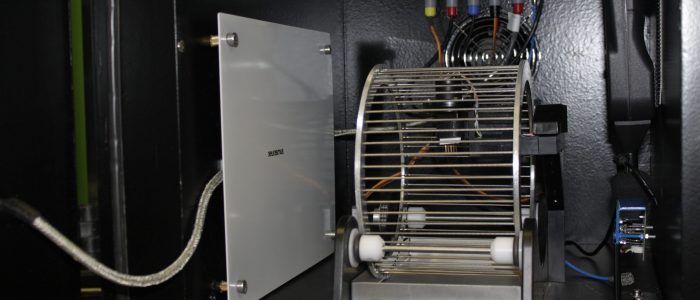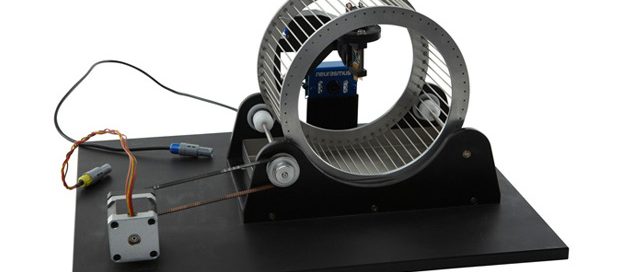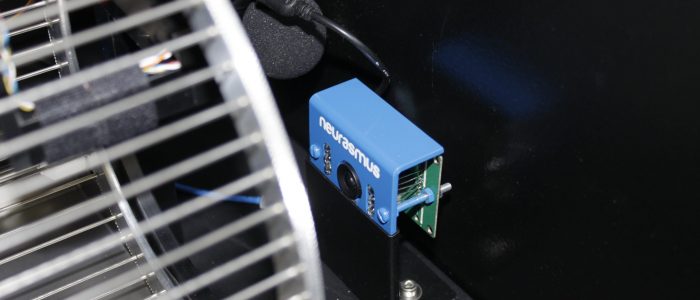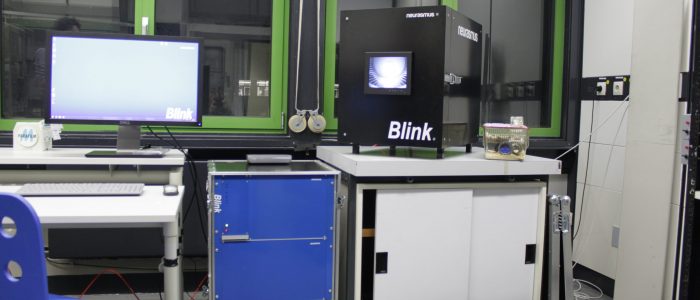- MDMT is the best method for eyeblink conditioning
- It is minimally invasive
- It is easy to use for the investigator
- Cost-effective system
What is Blink?
Blink is a scientific setup used for both eyeblink conditioning and prepulse inhibition of the startle reflex in animals. Classical eye-blink conditioning in mutant mice can be used to study the molecular mechanisms underlying associative learning. To measure the kinetic and frequency domain properties of conditioned and unconditioned eyelid responses in freely moving mice, we developed a method that allows adequate, absolute, and continuous determination of their eyelid movements in time and space while using an air puff as the unconditioned stimulus.
How Blink works?
Blink uses Magnetic Distance Measurement Technique for accurate measuring eyelid movements. The MDMT technique is based on a magneto-sensitive chip that measures the magnetic field of a miniscule magnet that is placed on the eyelid. No arbitrary threshold and integration tricks are needed for obtaining an accurate position and velocity signal of the eyelid.
A complete description of MDMT, compared to EMG and Video Tracking is available in:
S.K.E. Koekkoek, W. L. Den Ouden, G. Perry, S. M. Highstein, and C. I. De Zeeuw. Monitoring Kinetic and Frequency-Domain Properties of Eyelid Responses in Mice With Magnetic Distance Measurement Technique Journal of Neurophysiology 2002 Oct;88(4):2124-33.
Koekkoek SK, Hulscher HC, Dortland BR, Hensbroek RA, Elgersma Y, Ruigrok TJ, De Zeeuw CI. Cerebellar LTD and learning-dependent timing of conditioned eyelid responses. Science. 2003 Sep 19;301(5640):1736-9.
Publications
Schonewille M, Gao Z, Boele HJ, Veloz MF, Amerika WE, Simek AA, De Jeu MT, Steinberg JP, Takamiya K, Hoebeek FE, Linden DJ, Huganir RL, De Zeeuw CI. Reevaluating the role of LTD in cerebellar motor learning. Neuron. 2011 Apr 14;70(1):43-50.
Schonewille M, Belmeguenai A, Koekkoek SK, Houtman SH, Boele HJ, van Beugen BJ, Gao Z, Badura A, Ohtsuki G, Amerika WE, Hosy E, Hoebeek FE, Elgersma Y, Hansel C, De Zeeuw CI. Purkinje cell-specific knockout of the protein phosphatase PP2B impairs potentiation and cerebellar motor learning. Neuron. 2010 Aug 26;67(4):618-28.
Van Der Giessen RS, Koekkoek SK, van Dorp S, De Gruijl JR, Cupido A, Khosrovani S, Dortland B, Wellershaus K, Degen J, Deuchars J, Fuchs EC, Monyer H, Willecke K, De Jeu MT, De Zeeuw CI.
Role of olivary electrical coupling in cerebellar motor learning. Neuron. 2008 May 22;58(4):599-612.
Koekkoek SK, Yamaguchi K, Milojkovic BA, Dortland BR, Ruigrok TJ, Maex R, De Graaf W, Smit AE, VanderWerf F, Bakker CE, Willemsen R, Ikeda T, Kakizawa S, Onodera K, Nelson DL, Mientjes E, Joosten M, De Schutter E, Oostra BA, Ito M, De Zeeuw CI. Deletion of FMR1 in Purkinje cells enhances parallel fiber LTD, enlarges spines, and attenuates cerebellar eyelid conditioning in Fragile X syndrome. Neuron. 2005 Aug 4;47(3):339-52.



